IBCS System of F-35- Sensors
The US military recently completed a revolutionary test. In the Project Convergence 21 exercise, an F-35 fighter jet used the Electro Optical Calibration System (EOTS) to calibrate targets, uploaded the data to the Integrated Air and Missile Defense Battle Command System (IBCS), and then imported the information into the Army Field Artillery Tactical Data System (AFATDS) for artillery to fire at targets.
Although using aircraft as artillery observation planes is not unfamiliar, hot air balloons have been used for observation since the beginning of World War I, and after World War II, it has progressed to using light aircraft with radio communication. However, this is the first time that precise positioning sensors on fighter jets can be used for target calibration, and then extremely accurate coordinates can be transmitted to artillery, allowing artillery to attack at unprecedented speed and accuracy.
Integrated Air Defense andMissile Defense Battle Command System (IBCS)

IBCS is a large network architecture that integrates various shooting control networks and transmitters
The basic concept of IBCS is to connect various scattered radars onlinesensorAnd integrate the target information obtained from them, then allocate them to launchers suitable for dealing with various targets, and use the correct weapons to deal with them. In fact, IBCS is also a large architecture that integrates secondary command and control networks, including the Army Field Artillery Tactical Data System (AFATDS) and Integrated Fire Control Network (IFCN) mentioned above, which can achieve the effect of "sensor to shoot".
This system project began in 2009 and, after years of development, was awarded a $1.4 billion contract to Northrop Grumman (NG) on December 23, 2021, allowing for both low-speed initial and full speed production of IBCS. The US Army initially intended to use IBCS as the brain of its air and missile defense systems, but has now expanded its mission set exponentially.
If IBCS is used to integrate multiple systems, multiple radar systems can be used to monitor blind spots behind the terrain, rather than relying solely on radars within the battlefield.
In addition to the recently completed sensor integration testing of the F-35 mentioned earlier, IBCS has also conducted multiple live fire tests, including targeting simulated cruise missiles, ballistic missiles, and other targets. Even in a test integrating seven integrated fire control networks (IFCN), one of them failed due to wireless electrical interference. However, using IBCS's network architecture, the AN/MPQ-64 sentinel radar of other fire control networks was used instead of its own AN/MPQ-65 radar to lock onto the two incoming targets, and two Patriot 3 missiles were successfully launched to shoot down two different targets.
This test not only proves that IBCS can complement other functional systems in the event of interference in some systems, but also benefits from cross system collaboration, resulting in higher target accuracy information and making it more difficult for threats to use terrain to mask themselves, as many secondary radar systems may be placed in front of missile launchers and primary radar systems to compensate for blind spots that the primary radar cannot detect. The way to use the F-35 as a forward view and enable artillery to attack targets this time is to use the Army Field Artillery Tactical Data System (AFATDS) to target ground attacks. Therefore, in the future, as long as the system can be integrated into IBCS, there is a chance to use it as a forward view for curved fire, making the blind spots for firepower development smaller. IBCS has been developed at a cost of approximately $2.7 billion by the US Army and was approved for production in January 2021.
Source: Military of Strong Countries